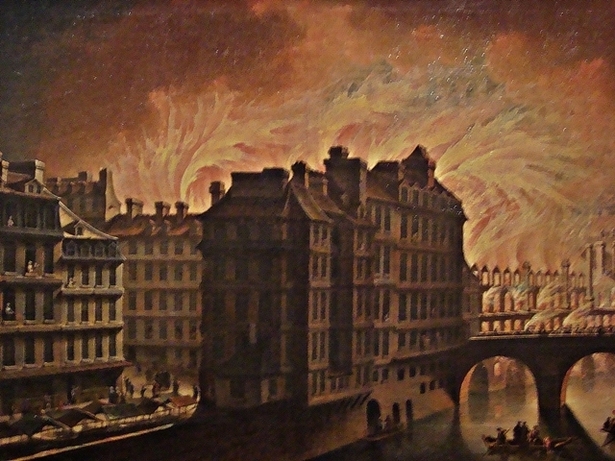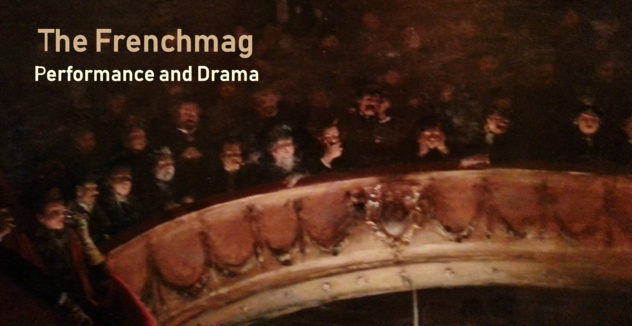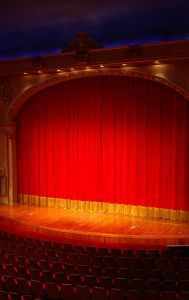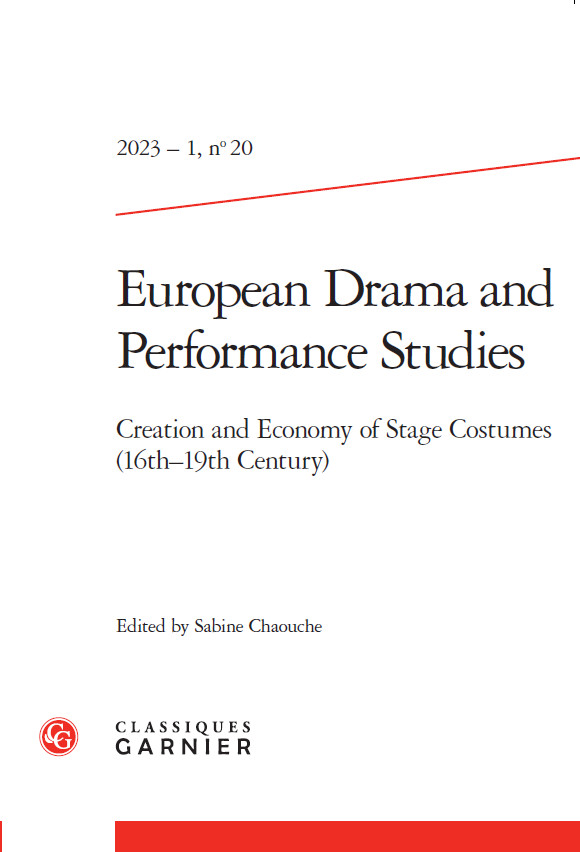
(c) photo de Sabine Chaouche - coll. Musée Carnavalet
The Comédie-Française actors stayed in the Saint-Germain area for more than 80 years.
The area became well known in Paris and Europe as the Comédie-Française quartier.
In 1770, actors moved to the right bank of the Seine. They claimed that the playhouse was too old and dilapidated, and was therefore dangerous to the audience. They needed a new playhouse and they were promised a new one by the king. Moving from the Saint-Germain area was a serious decision since the company had established its own network.
Interestingly, it seems that beyond safety concerns, actors were more worried by the Comédie-Italienne’s strong success in the 1760s. In fact, the location in Paris and the potential profit related to it were again a casus belli between the Parisian companies. Economic issues and rivalries were at the heart of the request made to Jean-Denis Papillon de la Ferté administrator of the Comédie-Française. In 1769, the Académie royale de musique was ready to move back to the Palais-Royal which had been devastated by a fire in 1763.
The repair works were practically done. La Ferté who fully understood the impact of location on income wrote a report to the first gentilshommes of the bedchamber about how to use Les Tuileries in the following years. He suggested that the Comédie-Italienne, of which he was also in charge, move to the Tuileries for few years while a new playhouse was being built for it in a better area. He argued that the quartier Montorgueil was clearly inconvenient (1) and unsatisfactory and this new playhouse was necessary to increase the company’s success and profitability.
Indeed the Comédie-Italienne’s debts had been cut and it was about to be the most profitable playhouse with privilege in Paris (the Académie royale de musique was constantly unprofitable, making huge losses, and the Comédie-Française which had been saved from bankruptcy in 1757, had not yet totally recovered, and was still in a fragile and precarious situation). As Papillon de la Ferté stated, “The Company makes huge amounts of money. I told them to be reasonable in their demands. I fear that the other companies will be very jealous of their success” (2) .
As result the move to the Salle des machines at Les Tuileries quickly turned into a quarrel between the actors from the Comédie-Française and the actors from the Comédie-Italienne. The Comédie-Française saw in the Tuileries a perfect opportunity to strengthen their business and therefore asked to move in there too. They claimed that they had a preemptive right over the Comédie-Italienne which was a ‘younger’ playhouse.
The hierarchy of the Parisian playhouses was maintained and the Comédie-Française was granted the Salle des Tuileries. Once established there, the actors actually realised that the new auditorium had many disadvantages. It was too big and they could not perform very well. Spectators of the time such as Grimm ironically mentioned in their chronicles that the place was not appropriate since actors could not be heard and their lack of talent was even more visible, making the company dismal and more awful than ever (3).
Lekain quickly wrote a request to M. de Sartine, the chief of police, pleading to come back to the Saint-Germain old playhouse. His request was turned down so he changed his strategy. He pointed out that the auditorium had to be adapted and reduced in size. He convinced the Duc de Duras to order the building work. The Duc de Richelieu and Monsieur de Marigny, agreed on it and they gave Lenoir the responsibility of doing the work in about two weeks. The Menus Plaisirs spent 8,000 livres on it. Papillon de la Ferté who did not approve of this choice, stated that the company had forgotten an important point: they would lose 40,000 livres per year since the auditorium would have fewer seats.
Moreover, as it appears through different bills relating to stage production, a lot of money had to be spent on the existing sets which had to be resized and adapted to the new auditorium (4), and also on freight since sceneries had to be moved from the Saint-Germain area, to the Tuileries where they had a small warehouse rue de la Baroulière (5). The old playhouse rue des Fossés-Saint-Germain was converted and transformed. It included a big warehouse on the ground floor and another warehouse outside in an adjacent house, the set-designer Brunetti’s, stagehands’, upholsterers’ (in the old café) and joiners’ workshops on the first floor as well as a candle shop (6). A lot of toing and froing had to be organised in 1771. We can see for instance that on the bill dated 31st May 1771 carriers had been ordered to move different pieces of scenery:
On 24th April. Two men to move Hylas’ tree to the Saint-Germain faubourg; to be painted again after the rehearsal; the same men to bring it back from the Saint-Germain faubourg to the Tuileries on the day of the performance on 10th May. One trip at ten sols for each man, that is 3 livres, plus another trip to bring the grass back.
On the 15th. 5 men to bring the four ceilings of the temple and the curtain. 2 trips per man, making it 10 journeys at 10 sols, i.e. 5 livres.
20th May. 2 trips by carriage to bring the scenery of the Genius and the jail in Beverlei, 7 livres etc.
Over the month the cost of these various moves amounted to about 50 livres which seems quite reasonable in comparison with other payments such as scenery adjustments, fabrics and clothing which could be per month ten to twenty times higher.
Although actors had new expenditures in their budget, they found a way to balance their budget and to cover their expenses by developing annual memberships. The income from the ‘petites loges’ (small boxes rented by spectators) was not shared with the author and was taken out of the daily income and was not used for ordinary or extraordinary expenses. The actors therefore fully benefitted from this income in their annual shares. The 1770s decade turned out to be a good one for the Comédie-Française.
Finally, in 1782, the actors were on the move again as their new playhouse was ready. Not surprisingly, the Saint Germain area had been chosen. The Odeon was located rue de Condé, not far from the rue-des-Fossés Saint-Germain des prés, which meant that the whole logistics built over the years could be maintained. Business was easier because the company could reduce expenses relating to freight and it no longer had any rivals in the area in which it was located. The Italian troupe had left Paris in 1780 and the remaining Opéra comique’s company had moved a year later from the Hôtel de Bourgogne to the Salle Favart which was located by the Porte de Richelieu (on the outskirts of Paris).
In fact all potential rivals were now located in the North West of Paris. From the 1780s the outlying quartiers of Paris expanded considerably.
The North West and East belt of Paris with its wide promenades became one of the most fashionable places, especially because of political decisions. The city council had decided in 1753 to improve and beautify the boulevards. Cafés, theatres, shops, musicians, illuminated groves and nice garlands made it an ideal place to entertain (7). As lively as the Saint-Germain fairground, the boulevards had a great advantage: they were not insanitary or dirty quartiers, they were constantly busy with peddlers selling cakes and sweets (oublies 8), sugar or cocoa, toys (such as the moulins-à-vent for kids) and various cheap goods. The Porte Saint-Martin was more and more highly esteemed for its entertainments and free street parades.
In 1784 the Académie royale de musique which had to move there because of a new fire at the Palais Royal asked for a privilège from all the playhouses located on the boulevards (9), i.e. they had to pay an annual fee if they wanted to include dance and music to their shows.
Beyond rivalries between theatres, the second part of the eighteenth century was strongly influenced by the development of the business of the theatre, in line with the urban development and the rise of consumption. Playhouses grew in number and many directors left their position in one of the three playhouses with privilège to open their own business such as Nicolet who worked at the Opéra-comique and later moved to the boulevard du Temple from 1759 to 1772, Taconnet who was a former stagehand at the Comédie-Française, Lécluze, former director of the Opéra-comique who opened the Théâtre des Variétés, rue de Bondy (that is to say by the Porte Saint-Martin), Audinot who made his debuts at the Opéra-Comique and at the Comédie-Italienne and who became director of the Ambigu comique.
The Comédie-Française admittedly kept its supremacy over the quartier Saint-Germain with a bigger and spacious auditorium (1 900 seats instead of 1 600). However, in the second part of the eighteenth century decisive changes had already modified the morphology of the Parisian space and Parisian behaviour towards the entertainments on offer. A new threat was coming from the growth of the city itself which accelerated the development of new forms of shows and entertainments at the periphery of Paris. It impacted upon the business of theatre. The new areas for money making were no longer areas in the centre of Paris or the Saint-Germain area, but the boulevards. Hence, at the end of the eighteenth century all the main playhouses, except the Comédie-Française, had moved to or were prospering on the boulevards, that is to say where the theatre industry would come into existence in the following decades.
Sabine Chaouche
The area became well known in Paris and Europe as the Comédie-Française quartier.
In 1770, actors moved to the right bank of the Seine. They claimed that the playhouse was too old and dilapidated, and was therefore dangerous to the audience. They needed a new playhouse and they were promised a new one by the king. Moving from the Saint-Germain area was a serious decision since the company had established its own network.
Interestingly, it seems that beyond safety concerns, actors were more worried by the Comédie-Italienne’s strong success in the 1760s. In fact, the location in Paris and the potential profit related to it were again a casus belli between the Parisian companies. Economic issues and rivalries were at the heart of the request made to Jean-Denis Papillon de la Ferté administrator of the Comédie-Française. In 1769, the Académie royale de musique was ready to move back to the Palais-Royal which had been devastated by a fire in 1763.
The repair works were practically done. La Ferté who fully understood the impact of location on income wrote a report to the first gentilshommes of the bedchamber about how to use Les Tuileries in the following years. He suggested that the Comédie-Italienne, of which he was also in charge, move to the Tuileries for few years while a new playhouse was being built for it in a better area. He argued that the quartier Montorgueil was clearly inconvenient (1) and unsatisfactory and this new playhouse was necessary to increase the company’s success and profitability.
Indeed the Comédie-Italienne’s debts had been cut and it was about to be the most profitable playhouse with privilege in Paris (the Académie royale de musique was constantly unprofitable, making huge losses, and the Comédie-Française which had been saved from bankruptcy in 1757, had not yet totally recovered, and was still in a fragile and precarious situation). As Papillon de la Ferté stated, “The Company makes huge amounts of money. I told them to be reasonable in their demands. I fear that the other companies will be very jealous of their success” (2) .
As result the move to the Salle des machines at Les Tuileries quickly turned into a quarrel between the actors from the Comédie-Française and the actors from the Comédie-Italienne. The Comédie-Française saw in the Tuileries a perfect opportunity to strengthen their business and therefore asked to move in there too. They claimed that they had a preemptive right over the Comédie-Italienne which was a ‘younger’ playhouse.
The hierarchy of the Parisian playhouses was maintained and the Comédie-Française was granted the Salle des Tuileries. Once established there, the actors actually realised that the new auditorium had many disadvantages. It was too big and they could not perform very well. Spectators of the time such as Grimm ironically mentioned in their chronicles that the place was not appropriate since actors could not be heard and their lack of talent was even more visible, making the company dismal and more awful than ever (3).
Lekain quickly wrote a request to M. de Sartine, the chief of police, pleading to come back to the Saint-Germain old playhouse. His request was turned down so he changed his strategy. He pointed out that the auditorium had to be adapted and reduced in size. He convinced the Duc de Duras to order the building work. The Duc de Richelieu and Monsieur de Marigny, agreed on it and they gave Lenoir the responsibility of doing the work in about two weeks. The Menus Plaisirs spent 8,000 livres on it. Papillon de la Ferté who did not approve of this choice, stated that the company had forgotten an important point: they would lose 40,000 livres per year since the auditorium would have fewer seats.
Moreover, as it appears through different bills relating to stage production, a lot of money had to be spent on the existing sets which had to be resized and adapted to the new auditorium (4), and also on freight since sceneries had to be moved from the Saint-Germain area, to the Tuileries where they had a small warehouse rue de la Baroulière (5). The old playhouse rue des Fossés-Saint-Germain was converted and transformed. It included a big warehouse on the ground floor and another warehouse outside in an adjacent house, the set-designer Brunetti’s, stagehands’, upholsterers’ (in the old café) and joiners’ workshops on the first floor as well as a candle shop (6). A lot of toing and froing had to be organised in 1771. We can see for instance that on the bill dated 31st May 1771 carriers had been ordered to move different pieces of scenery:
On 24th April. Two men to move Hylas’ tree to the Saint-Germain faubourg; to be painted again after the rehearsal; the same men to bring it back from the Saint-Germain faubourg to the Tuileries on the day of the performance on 10th May. One trip at ten sols for each man, that is 3 livres, plus another trip to bring the grass back.
On the 15th. 5 men to bring the four ceilings of the temple and the curtain. 2 trips per man, making it 10 journeys at 10 sols, i.e. 5 livres.
20th May. 2 trips by carriage to bring the scenery of the Genius and the jail in Beverlei, 7 livres etc.
Over the month the cost of these various moves amounted to about 50 livres which seems quite reasonable in comparison with other payments such as scenery adjustments, fabrics and clothing which could be per month ten to twenty times higher.
Although actors had new expenditures in their budget, they found a way to balance their budget and to cover their expenses by developing annual memberships. The income from the ‘petites loges’ (small boxes rented by spectators) was not shared with the author and was taken out of the daily income and was not used for ordinary or extraordinary expenses. The actors therefore fully benefitted from this income in their annual shares. The 1770s decade turned out to be a good one for the Comédie-Française.
Finally, in 1782, the actors were on the move again as their new playhouse was ready. Not surprisingly, the Saint Germain area had been chosen. The Odeon was located rue de Condé, not far from the rue-des-Fossés Saint-Germain des prés, which meant that the whole logistics built over the years could be maintained. Business was easier because the company could reduce expenses relating to freight and it no longer had any rivals in the area in which it was located. The Italian troupe had left Paris in 1780 and the remaining Opéra comique’s company had moved a year later from the Hôtel de Bourgogne to the Salle Favart which was located by the Porte de Richelieu (on the outskirts of Paris).
In fact all potential rivals were now located in the North West of Paris. From the 1780s the outlying quartiers of Paris expanded considerably.
The North West and East belt of Paris with its wide promenades became one of the most fashionable places, especially because of political decisions. The city council had decided in 1753 to improve and beautify the boulevards. Cafés, theatres, shops, musicians, illuminated groves and nice garlands made it an ideal place to entertain (7). As lively as the Saint-Germain fairground, the boulevards had a great advantage: they were not insanitary or dirty quartiers, they were constantly busy with peddlers selling cakes and sweets (oublies 8), sugar or cocoa, toys (such as the moulins-à-vent for kids) and various cheap goods. The Porte Saint-Martin was more and more highly esteemed for its entertainments and free street parades.
In 1784 the Académie royale de musique which had to move there because of a new fire at the Palais Royal asked for a privilège from all the playhouses located on the boulevards (9), i.e. they had to pay an annual fee if they wanted to include dance and music to their shows.
Beyond rivalries between theatres, the second part of the eighteenth century was strongly influenced by the development of the business of the theatre, in line with the urban development and the rise of consumption. Playhouses grew in number and many directors left their position in one of the three playhouses with privilège to open their own business such as Nicolet who worked at the Opéra-comique and later moved to the boulevard du Temple from 1759 to 1772, Taconnet who was a former stagehand at the Comédie-Française, Lécluze, former director of the Opéra-comique who opened the Théâtre des Variétés, rue de Bondy (that is to say by the Porte Saint-Martin), Audinot who made his debuts at the Opéra-Comique and at the Comédie-Italienne and who became director of the Ambigu comique.
The Comédie-Française admittedly kept its supremacy over the quartier Saint-Germain with a bigger and spacious auditorium (1 900 seats instead of 1 600). However, in the second part of the eighteenth century decisive changes had already modified the morphology of the Parisian space and Parisian behaviour towards the entertainments on offer. A new threat was coming from the growth of the city itself which accelerated the development of new forms of shows and entertainments at the periphery of Paris. It impacted upon the business of theatre. The new areas for money making were no longer areas in the centre of Paris or the Saint-Germain area, but the boulevards. Hence, at the end of the eighteenth century all the main playhouses, except the Comédie-Française, had moved to or were prospering on the boulevards, that is to say where the theatre industry would come into existence in the following decades.
Sabine Chaouche
(1) LA FERTE, Denis Pierre Jean Papillon de, Journal de Papillon de La Ferté, intendant et contrôleur de l’argenterie, menus-plaisirs et affaires de la chambre du roi (1756-1780), Paris, P. Ollendorff, 1887 ; Journal des Menus-Plaisirs du roi (1756-1780), Paris, Paleo, 2002, 29 mars 1769, p. 246.
(2) « Les Italiens font un argent immense. Je leur ai dit qu’en cherchant à trop gagner, ils n’excitassent beaucoup de jalousie de la part des Français. Cette réflexion ne leur a pas plu. » (id., 19 novembre 1764, p. 150).
(3) GRIMM, Friedriech Melchior Baron Von, Correspondance littéraire, Paris, Garnier frères, 1879 (16 tomes) ; 1878, tome IX, p. 55.
(4) Comédie-Française, Archives comptables, Mémoires des machinistes.
(5) BmCF, Mémoires des machinistes, Bill: May 1782.
(6) BmCF, Frais de peinture et de décor, Mémoire de 1782.
(7) LEVER, Maurice, Théâtre et Lumières, Les Spectacles de Paris au XVIIIe siècle, Paris, Fayard, 2001., p. 247.
(8) Confectionary made of sugar, honey and eggs.
(9) LEVER, op. cit., p. 269 : « Les Grands Danseurs du roi, l’Ambigu-Comique, les Associés, les Variétés-Amusantes poursuivaient leur brillante carrières sur le boulevard, lorsqu’un événement imprévu jeta la consternation parmi tout ce petit monde. On se souvient qu’après l’incendie du Palais-Royal, l’Opéra était venu s’installer à la porte Saint-Martin, tout à côté des théâtres forains. Or ce prestigieux voisinage allait bientôt se révéler catastrophique pour ces derniers, car plus leurs tréteaux attiraient de monde, plus ils excitaient la jalousie des artistes lyriques. Après mille vaines tentatives pour écraser leurs concurrents, l’Opéra obtenait, en juillet 1784, un arrêt du Conseil d’Etat par lequel le roi lui attribuait le privilège sur toutes les salles du boulevard, avec le droit de le rétrocéder à qui bon lui semblerait. »
(2) « Les Italiens font un argent immense. Je leur ai dit qu’en cherchant à trop gagner, ils n’excitassent beaucoup de jalousie de la part des Français. Cette réflexion ne leur a pas plu. » (id., 19 novembre 1764, p. 150).
(3) GRIMM, Friedriech Melchior Baron Von, Correspondance littéraire, Paris, Garnier frères, 1879 (16 tomes) ; 1878, tome IX, p. 55.
(4) Comédie-Française, Archives comptables, Mémoires des machinistes.
(5) BmCF, Mémoires des machinistes, Bill: May 1782.
(6) BmCF, Frais de peinture et de décor, Mémoire de 1782.
(7) LEVER, Maurice, Théâtre et Lumières, Les Spectacles de Paris au XVIIIe siècle, Paris, Fayard, 2001., p. 247.
(8) Confectionary made of sugar, honey and eggs.
(9) LEVER, op. cit., p. 269 : « Les Grands Danseurs du roi, l’Ambigu-Comique, les Associés, les Variétés-Amusantes poursuivaient leur brillante carrières sur le boulevard, lorsqu’un événement imprévu jeta la consternation parmi tout ce petit monde. On se souvient qu’après l’incendie du Palais-Royal, l’Opéra était venu s’installer à la porte Saint-Martin, tout à côté des théâtres forains. Or ce prestigieux voisinage allait bientôt se révéler catastrophique pour ces derniers, car plus leurs tréteaux attiraient de monde, plus ils excitaient la jalousie des artistes lyriques. Après mille vaines tentatives pour écraser leurs concurrents, l’Opéra obtenait, en juillet 1784, un arrêt du Conseil d’Etat par lequel le roi lui attribuait le privilège sur toutes les salles du boulevard, avec le droit de le rétrocéder à qui bon lui semblerait. »




